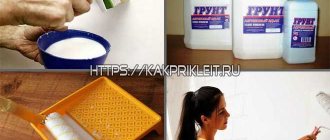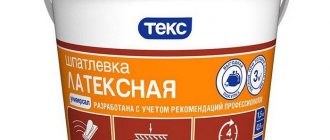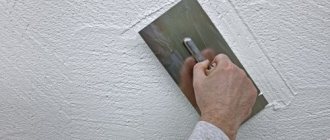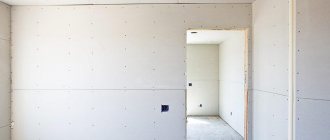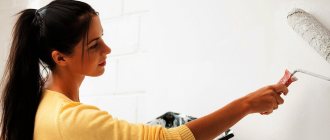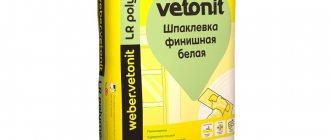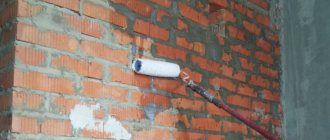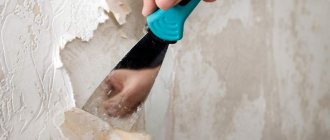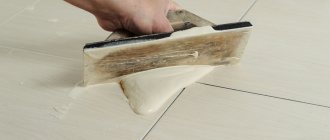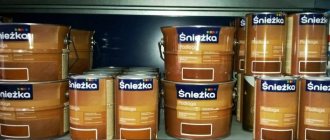Che Guevara
16434 0 20
Che Guevara December 12, 2016
Priming gypsum boards before finishing is required.
In fact, there are no secrets here: a primer for putty is absolutely necessary. However, there are many nuances, knowledge of which will help to avoid mistakes in the future. In this article I will answer common questions and share the nuances of priming work.
How long does it take for wall primer to dry?
The material contains polymer and other additives that improve adhesion and other qualities of the product.
The drying time of the mixture depends on the type of primer.
The following types can be found on the market:
- Slow drying
. Polymerization of the primer mixture requires at least 24 hours.
- Medium drying speed
. It takes 4-12 hours for the mixture to completely harden. To find out the exact drying time of the material, you should read the manufacturer's instructions indicated on the packaging.
- Quick-drying (in 1-2 hours)
. This group includes enamel and alkyd mixtures. It should be remembered that primers of this type are extremely toxic (can cause harm to health), but after treatment you can quickly begin applying decorative materials, wallpaper and other coatings.
When working with such a primer mixture, it is important to use protective gloves, a respirator and goggles (intended for construction work). It should be remembered that a mixture that hardens too quickly is not always useful, since the adhesive properties of such a solution are weaker, which can lead to surface deformation.
On a concrete wall
For concrete surfaces, an adhesive primer is most often used; it takes 24 hours for the mixture to dry completely. The speed of the process also depends on environmental conditions (degree of humidity, temperature, etc.).
On brick with plaster
Half a working day is required for polymerization.
On a concrete wall before plaster
It is not necessary to wait until the primer material has completely polymerized before plastering. The exception is some decorative materials.
On wooden walls
To coat wooden surfaces, high-quality primers are required; most often, builders use oil-based mixtures. The coatings dry within 12-24 hours, the time depends on the composition of the manufacturer’s mixture and the conditions of use (temperature, humidity level, coating thickness, etc.).
On the market you can find quick-drying oil-based compounds intended for interior work. For example, this is a mixture of Kilz Original (the material takes only 1 hour to dry).
Drying time for deep penetration primer
Often, before applying decorative materials, a deep penetration primer is used; it helps prevent the appearance of various stains on the base after drying, as well as ensure good adhesion for future coatings. The characteristics of these primers may vary between manufacturers. To allow the coating to dry, leave the mixture on the wall for 24 hours.
Which will dry the walls or ceiling faster?
The finishing material dries faster on the ceiling (thanks to warm air).
Possible errors
If you leave a specific wall without a primer, then the likelihood that defective areas of the surface will appear will automatically increase. It is absolutely wrong to refuse this type of work in order to save money. This is absolutely not cost-effective, because the service life of even the most expensive coatings will be quite short. Very quickly the walls will again need expensive repairs. Using a primer pays for itself in the long run.
Do I need to prime the walls before wallpapering? Definitely yes! In this case, soil mixtures are also capable of performing a very important fixing function, and also significantly save the consumption of wallpaper glue. To achieve your goals, you need to choose the right mixture. Experts prohibit the use of polymer dispersions and water-based paints as primers.
What affects drying time?
The following factors influence polymerization:
- Coating thickness
. The larger it is, the slower the evaporation process in the mixture occurs.
- Temperature
. Excessively high and low rates negatively affect the drying process. The recommended temperature for applying the primer is +15… +30°C. Humidity should not exceed 80%. If the indicators are lower, then polymerization will take longer.
- Mixture composition
. If earlier it was necessary to use the same primer composition for finishing work, today, thanks to the rapid development of industry and wide technological capabilities, it is possible to use different types of mortar (for different purposes and tasks).
- Best before date
. Please pay attention to this factor before using the product. The drying time, adhesion and strength of the coating depend on the quality of the solution.
How long should you wait before wallpapering?
Requires 4-24 hours.
How long to wait before applying putty
Most often, wait 12-24 hours before applying putty.
What determines the time for complete drying?
The drying process depends on certain factors:
- room temperature. The soil takes a long time to dry if the room is too hot or cool;
- the thinness of the applied layer speeds up the drying process;
- the primer mixture contains special additives that quickly evaporate from the wall surface;
- The drying time is affected by the structure of the walls. If the primer penetrates deep into the pores, it takes longer to dry.
In most cases, manufacturers indicate information about the constituent components and the time required for final drying of the mixture. In addition, the type of material used affects the drying speed. Acrylic compositions dry for at least five hours; alkyd mixtures will take much longer - up to a day. Griftal compositions take a long time to dry - you have to wait more than twenty-four hours. A water-based primer requires the least amount of time - after applying it, work can continue after twenty minutes.
Continuing to figure out how long after priming you can putty, here are a few rules that must be followed:
- a stable optimal air temperature is maintained in the room;
- drafts are eliminated.
It is prohibited to artificially accelerate the drying process.
Correct use of primer
Do not start decorating the wall until the primer material has completely dried. To find out exactly how long it will take for polymerization, study the information on the packaging.
To speed up the drying process of the primer, provide good ventilation in the room, lower the humidity level, increase the temperature, use a high-quality mixture, and distribute it over the surface using a sprayer.
The correct application technique is as follows:
- First prepare the surface. It is cleaned, degreased and dried. The adjacent areas are covered with paper. Before preparing the solution, it is important to read the instructions on the package so that it does not turn out too thick or liquid.
- The primer material is applied to the wall in a thin layer. If a secondary coating is used, the primer mixture is applied immediately before the first layer has completely dried.
- After priming, they begin to apply decorating materials.
The correct technology for applying deep primer:
- Before starting the process, prepare the base: remove the old coating (plaster, paint, etc.), because The mixture should only be applied to a clean, hard and stable surface. There should be no dust, grease or dirt on the wall, otherwise the mixture will not be able to properly attach to the base.
- Do not apply material that has expired.
- The mixture is applied to the surface at a temperature of +5…+25°C.
- To distribute the mixture on the wall, use a special brush or plush roller.
- During finishing work, use protective glasses and gloves.
Helpful Tips:
- Experts recommend using a dehumidifier when working to reduce the humidity level in the room.
- It is recommended to open windows to allow free air flow in the room.
- To create a thin layer on the surface, use a sprayer.
- It is very important to avoid any, even the slightest, drafts. Otherwise, the primer layer will not be able to dry evenly on the surface.
- It is not recommended to use dryers and other devices that produce hot air to speed up the polymerization process (by heating the wall). This procedure will not reduce the drying time, but will only worsen the adhesive properties of the material.
What functions does the primer perform?
- A layer of applied primer, getting inside, makes the treated surface more durable.
- The applied layer gets into all the pores and cracks, resulting in the formation of a “protective film” on the wall. As a result, less paint or putty is required.
- Thanks to the primer layer, the paint will be applied more evenly and there will be no streaks or stains.
- Some types of primer, in addition to their intended purpose, also protect walls from the appearance of fungus and mold.
- The applied layer of this product helps to adhere more thoroughly to the putty.
Compositions of primers and their setting period
The primer material plays an important role in the finishing process, so when choosing, you should carefully pay attention to its composition and properties. The choice of a particular product depends on the room, type of surface and many other factors.
The following types of solutions can be found on the market:
- Acrylic
. Manufactured on the basis of acrylic resins. Suitable for almost any substrate, the primer is evenly distributed over the surface, hiding minor defects. The technology allows the mixture to be applied to the wall in a thick layer.
- Alkyd
. Most often, such coatings are applied to textured solid substrates (PVC tiles, steel, wood, metal, etc.).
- Alcohol
. Suitable for finishing wooden walls.
- Clear primers
(made on a water basis). Designed for treating interior walls.
- Mineral
. Produced on the basis of cement and mineral elements. Suitable for priming brick, concrete and other types of walls.
- Anti-corrosion
. Manufactured on the basis of polyvinyl resins. Provide good adhesion to various types of surfaces and are highly resistant to corrosion. It is recommended to apply the mixture in a thin layer (as opposed to an acrylic primer). The material is suitable for coating steel, aluminum and galvanized substrates.
- Primers for dry walls
. The compositions are most often used to coat drywall. The mixtures perfectly close pores and provide an even layer on the surface. The primer helps seal the drywall, prevents it from cracking, and prevents the penetration of solvents contained in the finish coat.
- Epoxy
. Made on the basis of epoxy resin. The compositions are highly resistant to mechanical damage. An epoxy mixture is used to coat steel and concrete walls. The composition contains anti-corrosion additives and components that ensure good adhesion of the primer to the base. The mixtures are widely used both in the automotive industry and in construction.
The main advantages of epoxy primer:
- insulating and anti-corrosion properties;
- good adhesion to various types of substrates;
- Suitable for application on steel, zinc and aluminum.
When choosing a primer material, not only climatic conditions, the type of base, but also the composition are taken into account.
The wrong choice of primer can negatively affect both the quality of repairs and health (there are building materials that are not intended for use in residential premises).
You need to know how long it takes for different compositions to dry:
- Acrylic primer requires a minimum of 8 hours.
- For oil solutions, the time is more than a day (quick-drying oil primers that can dry in 6-7 hours are also available for sale).
- Alkyd solutions dry in 10-12 hours.
- The drying time of the epoxy primer is 90 minutes at a room temperature of + 20°C and 30 minutes at a temperature of 60°C.
- Water-based latex primer polymerizes quickly (in 30-60 minutes, for some formulations - in 1-2 hours). The rate of polymerization also depends on the thickness of the applied layer.
- Primers for dry walls dry within 30 minutes, for some manufacturers - within 2 hours, there are also compositions that require more than a day. Environmental conditions such as temperature and other factors play an important role in the polymerization rate of the primer material.
Composition of mixtures
You can prime the walls with various mixtures, which are made from different components; there are the following primers:
- Based on an organic solvent, they are made from alkyd or other resins. These mixtures are used for application to wooden surfaces, chipboard and fiberboard, and those materials that are painted with oil paint. They are also used for coating plastic, glass and metal products;
- water-soluble mixtures are usually made from acrylic, silicone or silicate materials. Such primers are considered universal; they can be used for any wood, brick, concrete, as well as plasterboard. This type of mixture is considered breathable, it prevents the accumulation of moisture. Most often, such compositions have no odor;
- primers made of polyurethane, epoxy, shellac resins are specialized mixtures and are used quite rarely;
- a mixture based on PVA has many disadvantages: it does not allow air to pass through, forms an airtight film, which after a while begins to quickly peel off, so it is quite rare to prime with PVA compounds;
- alkyd mixtures are most often produced from zinc chromate; they are universal and can be used for all types of substrates. Sometimes these primers are made from phosphate, which gives them anti-corrosion properties. After application to the surface, they can be painted with any alkyd paint;
- mineral primers are usually used to level and strengthen brick and concrete structures. Such compositions are usually made from cement, gypsum and lime.
What affects the setting speed of impregnation?
Main factors:
- Low temperatures slow down the drying of the primer. If the room is cold, it is recommended to increase the temperature.
- Oil-based primers take much longer to dry than water-based ones. Some manufacturers' compounds dry more slowly, because... the mixture contains more oil. To speed up the polymerization process, choose a brand with less oil and more pigments.
How to properly putty walls after applying primer?
The process of applying putty to primer is very important. During repairs, a large number of people think about whether it is possible to apply putty immediately on the primer, because this can help save time spent on repairs. The primed surface must dry thoroughly in order to form a protective layer on the surface, which is why putty cannot be applied immediately.
Primed walls, when should they dry?
The minimum time is 1-4 hours (for quick-drying compounds), the maximum is 48 hours.
Drying time for popular compositions:
- Kills primer is oil or latex based. The primer dries before applying putty for 1 hour (at optimal temperature and humidity). The mixture perfectly insulates the coating and prevents the growth of mold and mildew.
- The Rustoleum Primer mixture dries for 1 hour at temperatures of +21...+27°C and humidity 50%. After applying the primer, you can begin decorating the wall.
Main tasks
It is not difficult to determine whether it is necessary to prime the walls before laying tiles, because these mixtures significantly improve the quality of adhesion of various materials to the surface. Even tiles in this case are no exception. Thanks to the primer, the base itself becomes stronger, which will allow the wall to withstand the load much more easily.
Even if some parts of the base do not adhere to each other very well, then this circumstance can be changed with the help of a primer. Do not forget about the protective capabilities of soil mixtures. As a result of their use, the walls will be reliably protected from the occurrence of fungi, mold and other pathogenic bacteria. You can achieve the best result only if you choose the right primer for a specific finishing material.
It is easy to understand whether the walls need to be primed before plastering or applying other finishing materials. Soil mixtures have a lot of positive properties, which is why experts do not advise saving on this action.
If you find an error, please select a piece of text and press Ctrl+Enter.
